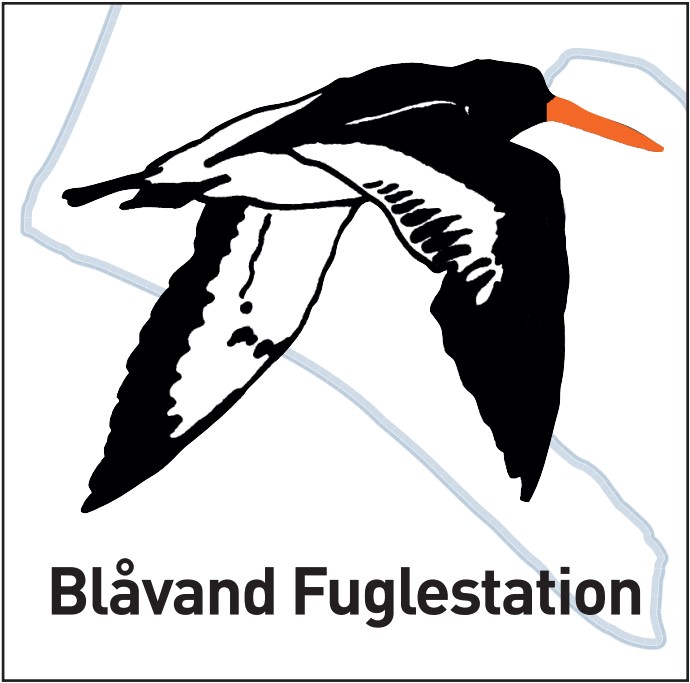Her på Blåvand's blog bringes korte nyheder i dagbogsformat om livet og hændelser på fuglestationen.
Sæsonens, hvis ikke årets, bedste fugl!!
Morgenobs
På nuværende tidspunkt har i sikkert læst dagens overskrift og ved at der er sket noget sindssygt spændende i Blåvand. Jeg vil ikke løfte sløret helt endnu, man lade jer hænge lidt på en cliffhanger.
Dagen startede nemlig på klassisk november maner med sydøstenvind og en halv stille morgen. Lunt og dejligt, godt med ederfugle, over to hundrede bramgås og 45 kortnæbbede gæs samt hele to flokke på fem fløjlsænder i hver. Bestemt ikke værst. Allerede kl 09 begyndte bombadementet af beskeder, på kommunikations appen Zello, fra stationslederen Henrik Böhmer. Han meldte først en hvidbrynet løvsanger og en fuglekongesanger ud fra det lange krat på grønningen. Utrolig lækre semisjældne sibiriske fugle, men utroligt nok ikke dagens højdepunkt. Henrik kommer med endnu en besked, han har en sjov sanger som sidder og småsmasker lidt i krattet. Måske en schwarz løvsanger... Der går lidt tid og så kommer meldingen som får det til at løbe koldt ned ad ryggen på os. Han har både klokkeklare kald optaget og et utroligt godt billede til identifikation. Det er intet mindre end en CETTI SANGER!! Kun andet fund for landet, hvor den første blev ringmærket i skagen. Så den første Cetti sanger udenfor net. Henrik har lige lagt sæsonen største guldæg! Jeg må ærlig indrømme at Oliver og jeg havde svært ved at tælle sortænder efter dette. Tankerne var sjovt nok andet steds. Vi pakker hurtigst muligt sammen og fræser ned mod grønningen for at se den sjældne fugl. Kort efter kommer Mathilde drønende med en sand fuglekiggers drift, hun har praktisk talt indhentet bilen og kan køre cyklen direkte ud i mudderet. Henrik står og modtager os og vi hører alle den karakteristiske smaskende kald efterfulgt af en blød trillen lidt alla en lækker version af en gærdesmuttes. Vi ser den desværre ikke, da det er en enormt sky art. Men vi er heldige nok til at være blandt de første fem på pletten inden alle twitcherne kommer og koruperer de gode lydfiler med småsnak. En absolut fantastisk fugl og absolut sæsonen mest interessante fund!
Måske årets bedste fugl, en Cetti sanger. Foto; Henrik Böhmer
Dagen er dog ikke slut endnu. Min (Sverre) bedstemor er ankommet til Blåvand for at besøge mig og se hvad jeg bruger tiden på herude vestpå. Jeg mødes med hende, lige tidsnok til at høre Henrik kalde en Thorshane ud et andet sted på grønningen. Den er rastende og ligger i en smuk glorificeret vandpyt. Den venter pænt på at min bedstemor og jeg, samt resten af hr og fru danmarks fugleverden ankommer. Jeg ser den halvdårligt da det går op for mig at jeg har glemt mit teleskop på stationen i min iver for at se Cetti. Bent Jakobsen ankommer heldigvis hurtigt til svømmesneppen og låner mig sit teleskop, hvorefter jeg tager et hurtigt billede til jer. Endnu en lækker fugl i dag.
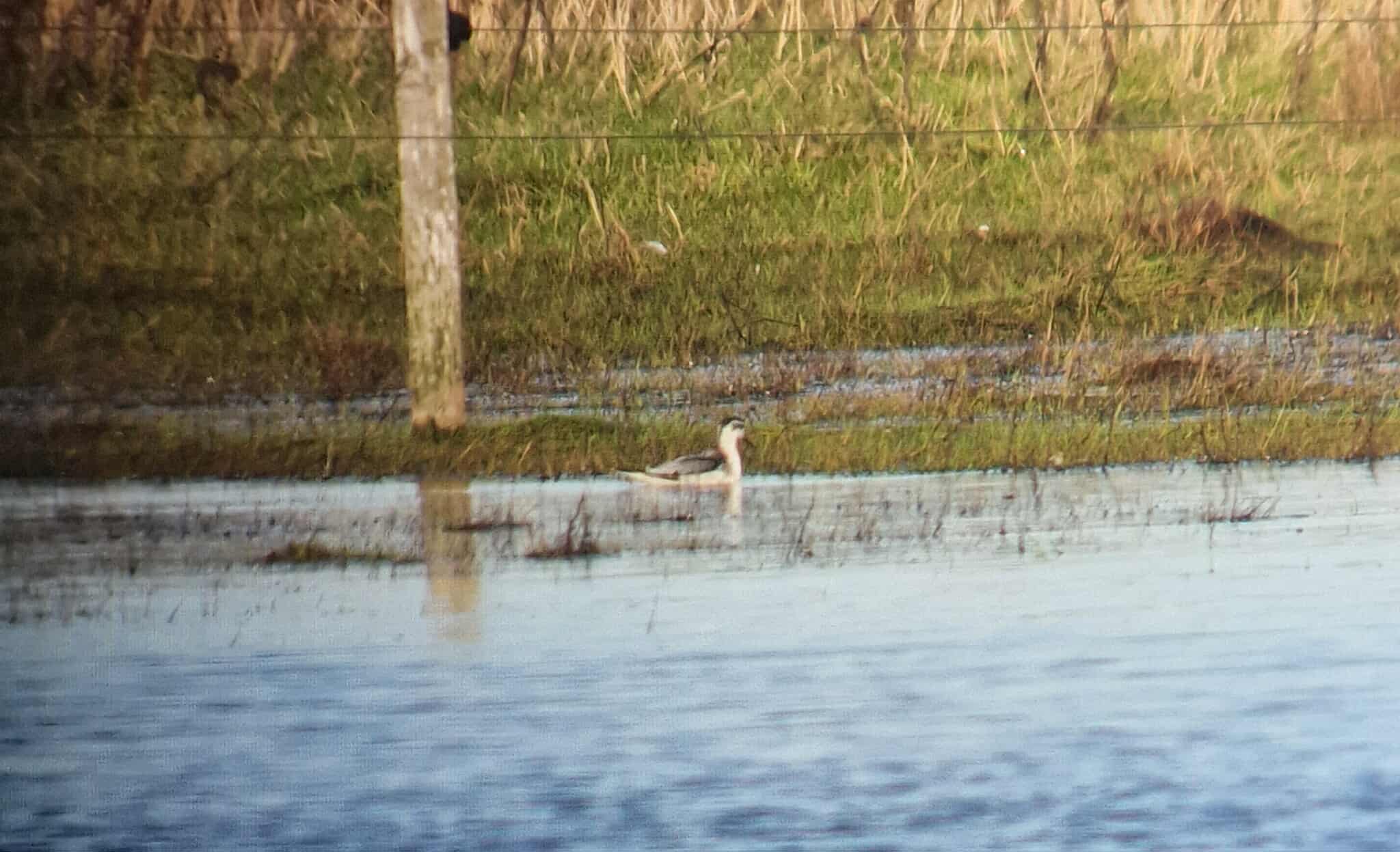
Den lækre Thorshane. Foto; Sverre Dahl Porsgaard
Imellem siberiske sangere, Cetti og svømmesneppen finder Henrik selvfølgelig også en bjergpiber. Endnu en semisjælden fugl, dog mere udbredt end de andre her på grønningen. Med de førnævnte rariteter og himalaya sangeren i tipmosen (som stadig var at finde i dag) er der således fire subhits og to SU-arter i blåvand i dag! Til de fuglekiggere som ikke fik Cetti sangeren i dag skal dog nævnes at ved nærmere lydanalyse har Henrik optaget et kald fra den allerede i mandags, så den kan sagtens tænkes at blive i området lidt endnu;)
I dag var i sandhed en fantastisk dag at være på fuglestationen! Endnu en god dag i Blåvand.
- SDP
Ringmærkning
Efter et par grå morgener, stod vi op til en smuk lyserød solopgang. Det gjorde os spændte på hvad morgenen ville bringe af fugle i nettet - og vi blev ikke skuffede!
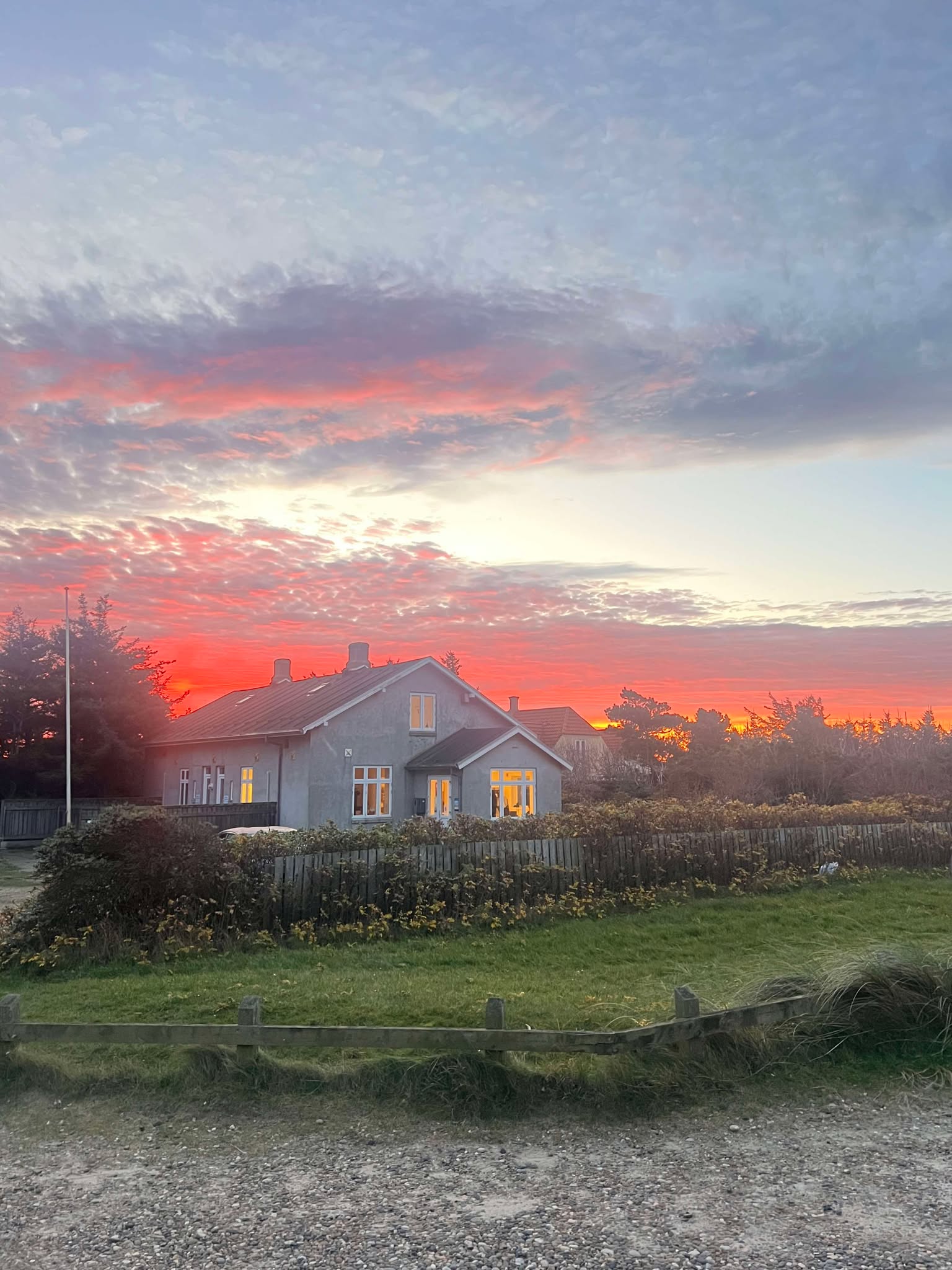
Smuk solopgang over stationen. En ny dag gryr i Blåvand.
Efter et par stille og rolige runder, var der pludselig et net fyldt med blåmejser. Vi kiggede på vores stadig let medtagne fingre og blev lidt nervøse. Får vi en 400 blåmejser-dag igen? Det blev dog ikke til den helt samme blåmejseoverflod. Fordelt på et par timer, kom vi op på 101. Fedt!
Senere blev vi beriget med en nuttet flok svenske halemejser. Gruppen bestod af både den nordlige og sydlige underart, og en af dem havde altså en ring der stod "Stockholm" på! Det er altid sjovt at kunne se dem side om side til sammenligning.
- SV
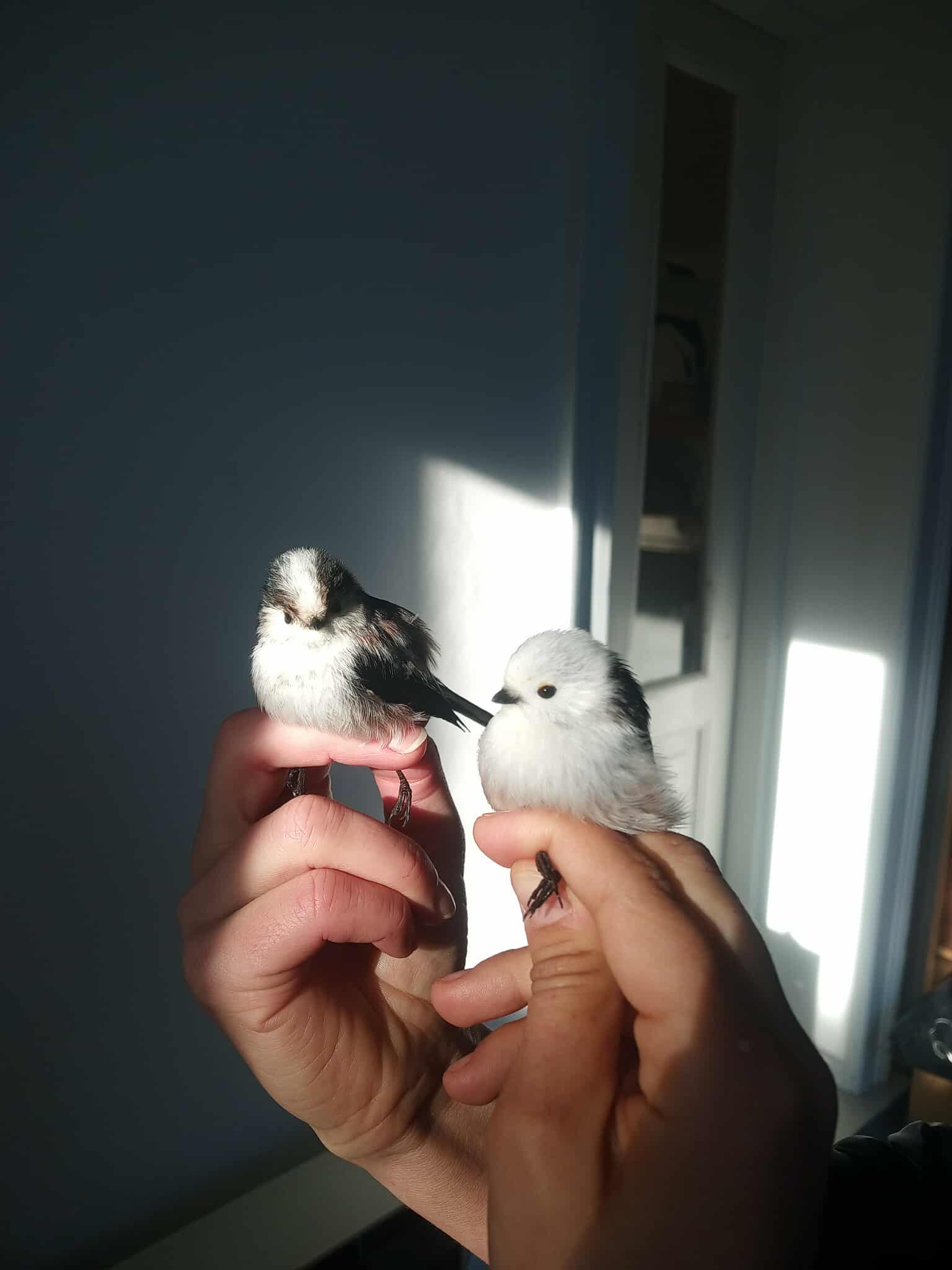
Halemejser - sydlig til venstre og nordlig til højre for sammenligning.
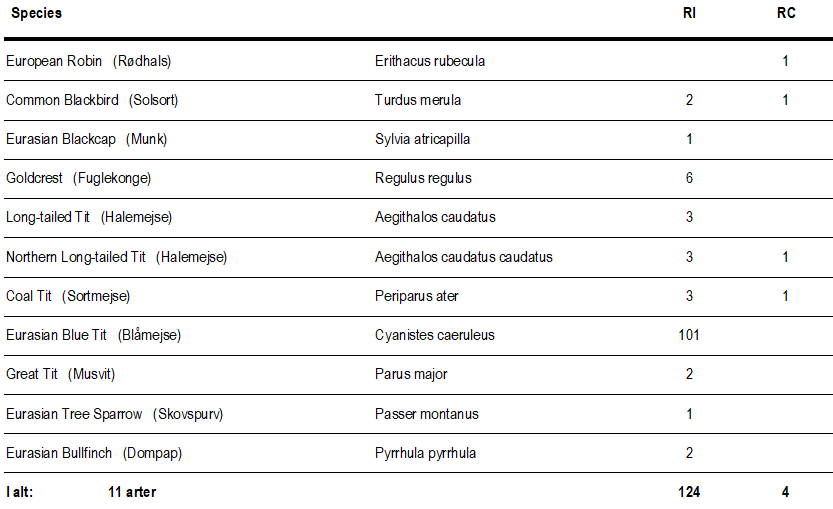
Folk på stationen: Lua Koplin, Sverre Dahl Porsgaard, Mathilde Lundt Larsen, Oliver Laursen, Selina Veng, Thomas Kristensen, Bent Jakobsen, Henrik Böhmer, Sverres bedstemor Kirsten
Stor kjove eller storkjove?
Morgenobs
Da vi satte os til rette i hullet havde vi ikke de store forhåbninger til fugletrækket, men vi blev positivt overrasket af en ny gæst og en efterhånden vant fugl. Trækket startede temmelig kedeligt med få og samme trofaste fugle som vi er vant til, dog med få indslag fra toppet lappedykkere og havlitter. Som vi sad og kedede os lidt, kom Anders Myrtue og hjalp med trækket selvom det var langsomt på daværende tidspunkt. Dværgmågerne begyndte at stige i tal for hvert interval vi kom frem på så vi valgte at blive lidt længere end standard tid sådan at alle dværgmågerne kom med. På stranden sad der en kjove som vi ikke lige kunne bestemme uden at se undervingen. Jeg (Oliver) håbbede på en mellemkjove da det er en art der virkelig har undgået mig i den tid jeg har set på fugle. Sverre blev efterladt på obsposten så jeg kunne få nogle bedre billeder af fuglen. I mellemtiden var der nogle tyskere der gik over pælerækken mens militærområdet var spærret så soldaten der stod på post måtte skælde dem ud med det tysk han nu kunne. Der lød en del "RAUS!", "WEG!" og "VERBOTEN!", men han fik dem ud og Anders og jeg fik os en sludder med soldaten. Vi spurgte ham også om ikke vi kunne få lov at liiiiige gå over pælerækken for at få bedre billeder af den kjove der, men det måtte vi dog alligevel ikke. Heldigvis fløj kjoven så mod os og vi kunne se at det var en klar og tydelig storkjove og den må få prisen som dagens fugl, sammen med de 108 dværgmåger vi havde idag.
- OLA


Storkjove rastende på stranden. Billeder: Mathilde Lundt Larsen
Ringmærkning
En stille og rolig dag startede godt ud i ringmærkningen med solsorte og fuglekonger, som de tidligste gæster, og endte i en grupp mejser - som vi også kender det. De største flokke af blåmejser tænker vi må være ovre, men en mindre flok på 13 blåmejser gav alligevel lidt påmindelser om tidligere tider.
En bogfinke glædede mig, da finkerne er lidt periodvis fåtallige afhængigt af vejret, selvom hvis der er mange overflyvende.
Også en del munke lægger vejen forbi Blåvands net lige nu, deriblandt denne ret unge 1k munk han. Man kan se på de munke, vi fanger nu, at de sandsynligvis er født rimelig sent på sæsonen i sommers og er de sidste, der trækker længst fra - måske fra de norske fjelde.
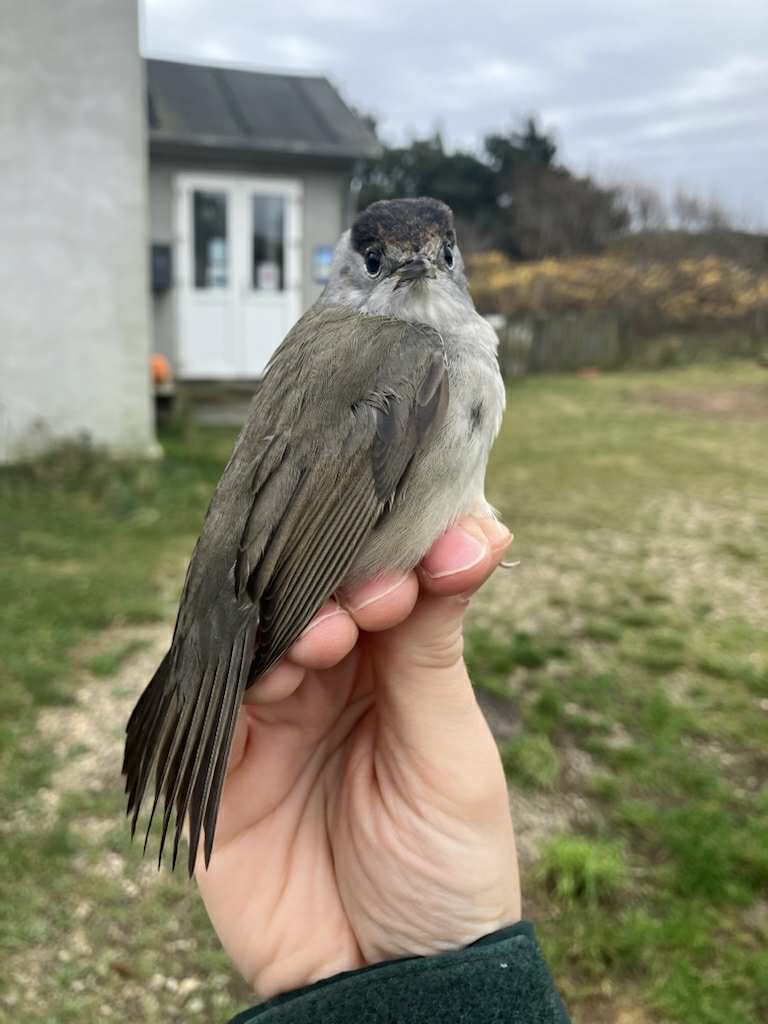
1k munk han.
- MLL

Folk på stationen: Lua Koplin, Sverre Dahl Porsgaard, Mathilde Lundt Larsen, Oliver Laursen, Selina Veng
Hello to Selina
Morgenobs
The southwestern wind did not bring a lot of interesting birds today. Some little gulls and a single velvet scoter might have been the most interesting bird. Had it not been for a late arctic tern fouraging and the gulls. A slow day with only 27 species. A cozy day none the less with up to 13 degrees celsius:)
- SDP
Ringing
Today we got back into our normal ringing routine and for this week, we'll have a new ringer with us! Meet Selina, who has previously ringed in Skagen!
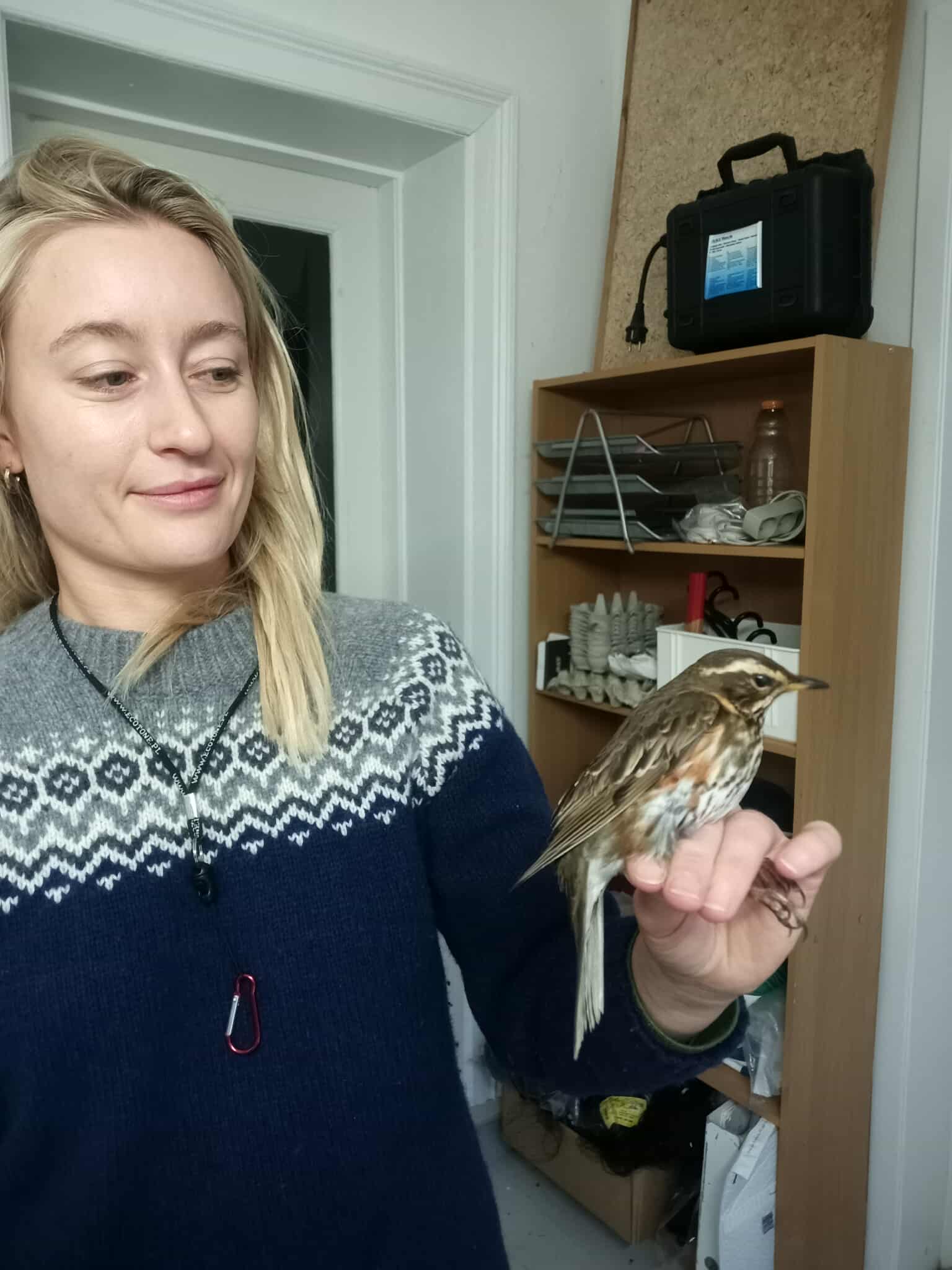
Our new ringer Selina and an beautiful redwing.
Her first official Blåvand bird was this beautiful redwing! Besides the redwing, we also got blackcaps, goldcrests and blackbirds! In the last round we got this amazing blackbird and robin in the same net, I think they are friends!
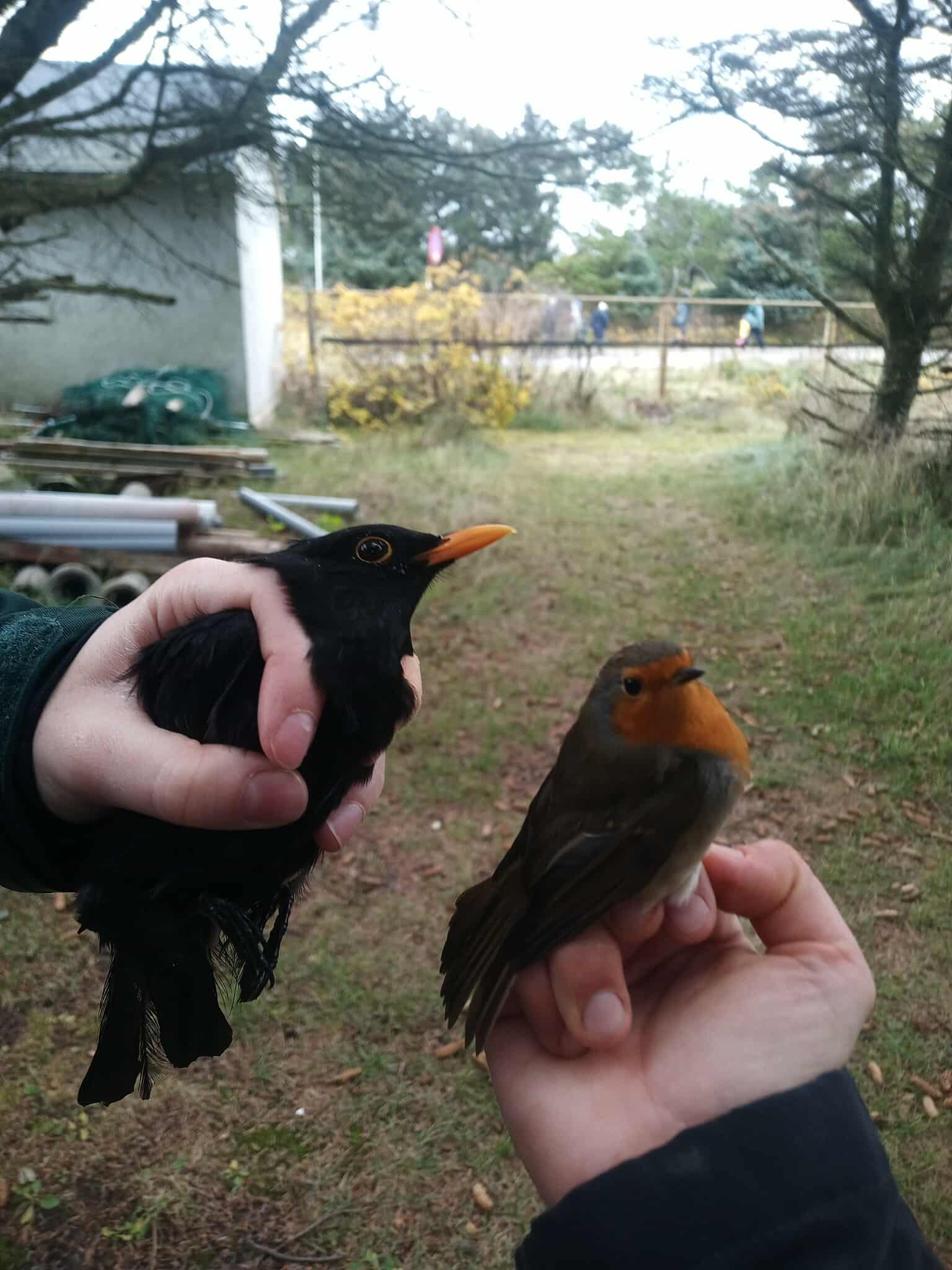
A 1k blackbird and 1k robin.
- LK
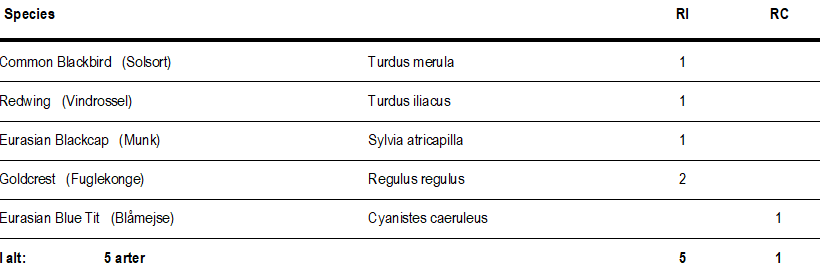
Folk på stationen: Lua Koplin, Sverre Dahl Porsgaard, Mathilde Lundt Larsen, Oliver Laursen, Selina Veng
Lidt diversitet i nettene
Morgenobs:
Dagen startede med en jævn vind fra SV med en nogenlunde klar himmel og god sigt. Fra hullet kom et stille og roligt træk af de sædvanlige fugle, med den forskel at fuglene kom tæt på idag! To nordiske lappedykkere kom bag brændingen og kunne nydes af de fremmødte på dagens morgenobs, på den ene af fuglene kunne det sorte over øjet endda ses. Stærene kom i fine tal med ca 2000 fugle i alt. Dværgmågerne kom også tæt på foran brændingen. Pludselig som jeg (Oliver) sad og kiggede langs vandet, svømmede der en større lom på havet, jeg melder islom men så er den som sunket i jorden, hvor ingen andre ser den igen. I det sidste interval kom den pludselig trækkene tæt på over horisonten og jeg tager et billede af den, billedet kan ses på dofbasen da jeg ikke har en SD-læser. Selvom havternen er halvsjælden på dette tidspunkt, var der pludselig en der fouragerede i strandkanten og forsøgte at fange fisk. Dagens morgenobs er dermed godkendt med fine fugle tæt på.
Andet spændende at nævne, er vores nye ringmærker Selina som er med os i en uge og hjælper ringmærkerne med alle deres blåmejser. Så tre ringmærkere og to observatører har nu ophold på stationen den kommende tid, vi håber Selina nyder hendes ophold i den uge hun har med os :)
- OLA
Ringmærkning:
Denne nye uge startede ud med friske pust men ikke mere end, at vi kunne åbne net. En varieret og rolig dag med syv forskellige arter i løbet af formiddagen, inden regnen igen slog til ved middagstid. Især oplever vi, at solsortene tager til i antal med ankomsten af november.
Af spændende fugle kan tælles en genfangst af en gærdesmutte, som viste sig at være ringmærket som 1k i efteråret 2022 her i Blåvand - nu tre år senere er den tilbage. Den havde en særlig vingefjer, der var helt snehvid og muligvis i udgroningsfasen, samt halefjer der også var ved at skiftes.
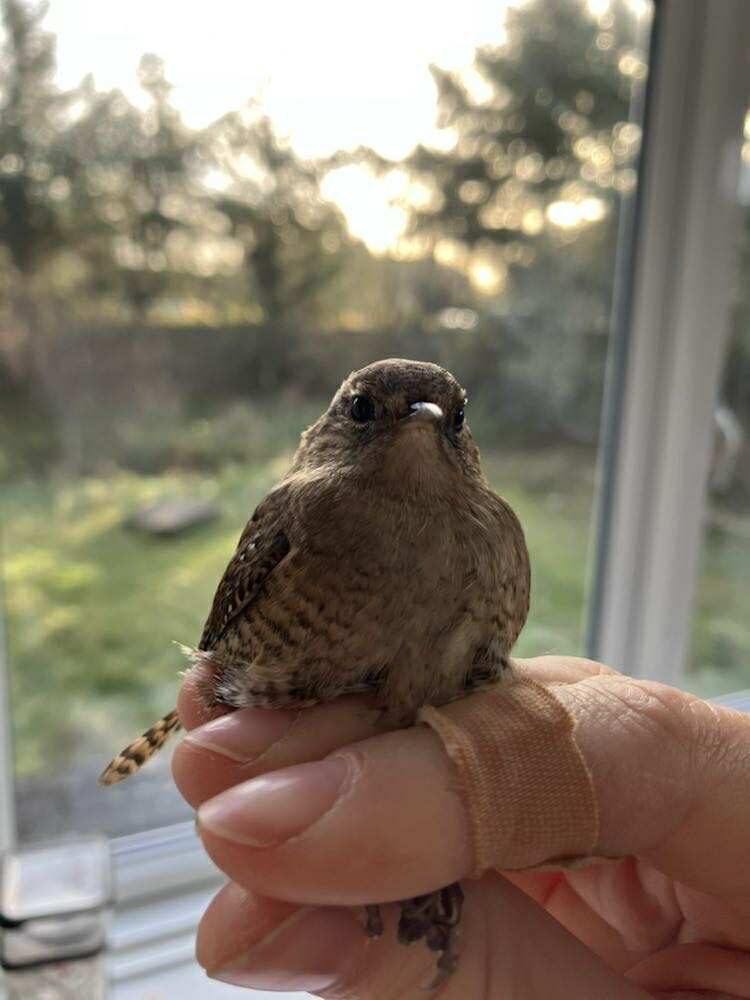
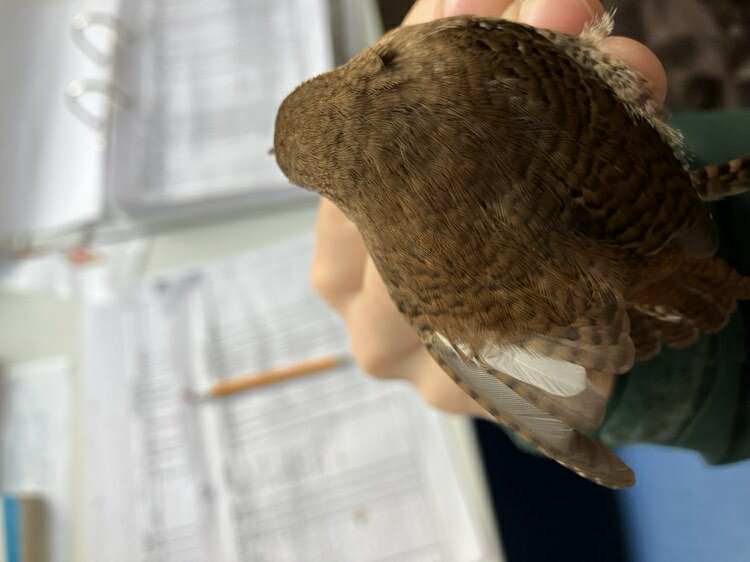
Adult gærdesmutte med interessante vingefjer.
1k solsortene er begyndt at være så langt i deres fældning, at de har fået deres farve og hos hannerne, kan man se deres gule øjenringe. En af dem vi fangede i dag havde næsten skiftet farve på sit næb, men manglede blot en enkelt stribe på siden, så det næsten lignede en moustache.
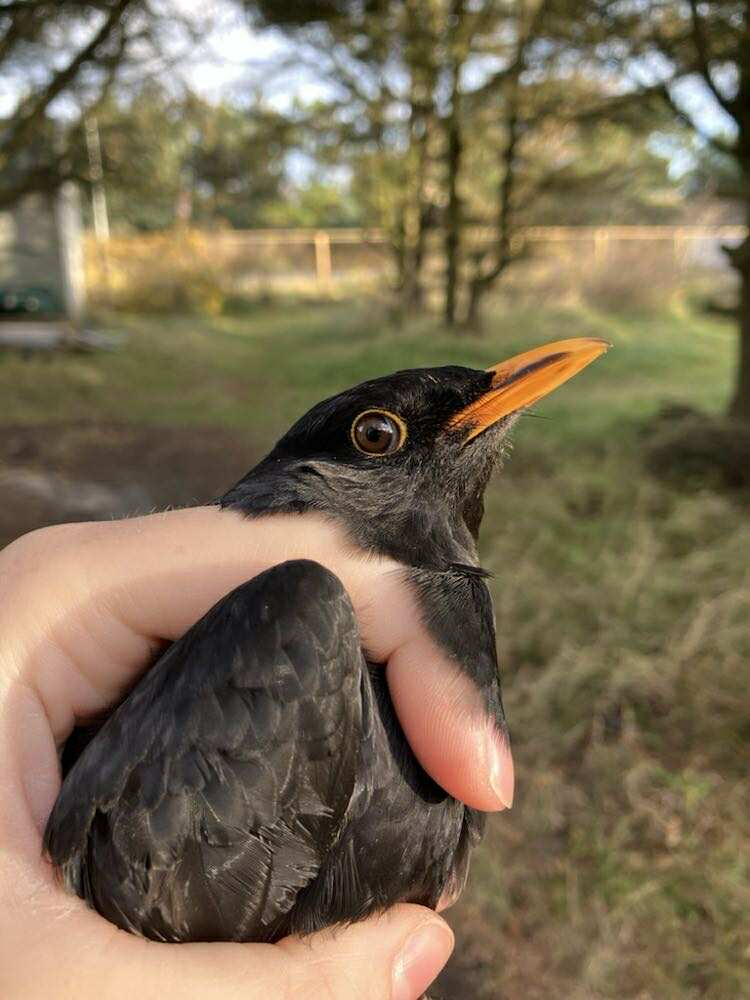
Moustache 1k solsort han.
En sidste fin fugl fra i dag er denne 1k dompap han, en af de lidt sene - så jeg nyder dem, når de er forbi, selvom vi også passer godt på at de kommer godt videre. De følges ofte i flok, men denne han blev fanget alene i nettet. Da jeg slap den fri, hørte jeg en anden kalde på den fra det nærmeste træ. Den kunne flyve direkte op til sin artsfælle, så de forhåbentlig kan følges sammen ad længere ud og trodse novembervejret.
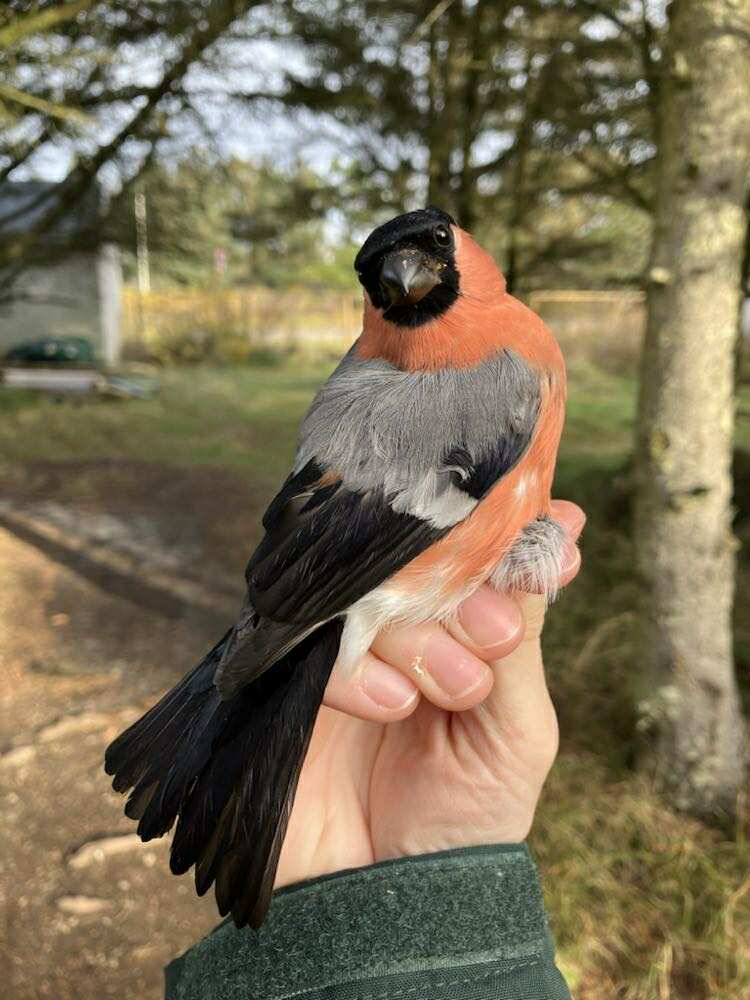
1k dompap han.
Endnu en dejlig dag i Blåvand!
- MLL
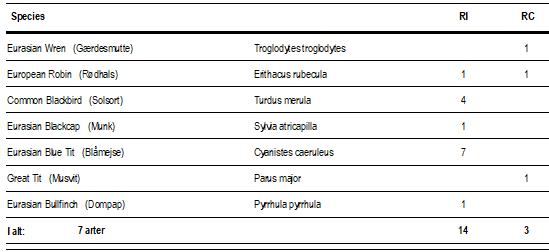
Folk på stationen: Lua Koplin, Sverre Dahl Porsgaard, Mathilde Lundt Larsen, Oliver Laursen, Selina Veng, Henrik Böhmer, Bent Jakobsen
Humes for lunch
Morgenobs
The weatherforecast did not hold up today. We were promised small and fragile winds but enden up with upwards to 9 meters per second from west-southwest. Not a bad windredirection. We were nine people at the obs today, so everything was covered. Not a lot to see though. Bird of the day (from the obs at least) is a single little aulk flying south before resting for a bit on the water. Besides from that we saw some goldeneyes (hvinand), long tailed ducks (havlit), wigeons (pibeænder), teals (krikand), pintails (spidsand) and ofcourse scoters. We enden up with 66 species in total throughout the day, not a bad day at all!
Around middat Anders Myrtue found a nice Humes warbler (himalaya sanger) that we all went to see. That is definitely a new species for me, and also for Oliver who might have just hit number 300. Congratulations! What an amazing milestones. We all got to see it and i am currently working on a sound recording of the rare bird to act as proof. Thank you to Anders Myrtue and also thanks to my parents who have been here for the last day and drove us to the Humes warbler! What a thrilling day in Blåvand:)
- SDP
Ringmærkning
Tonight we probably had some of the heaviest rainfall that I (Lua) have witnessed during my time here and it dragged on untill the early morning hours. Therefore we opened the nets a bit later and had a slower day compared to what we have had lately. It started with one beautiful redwing(vindrossel) who's beauty also impressed Sverres mother who came to visit.
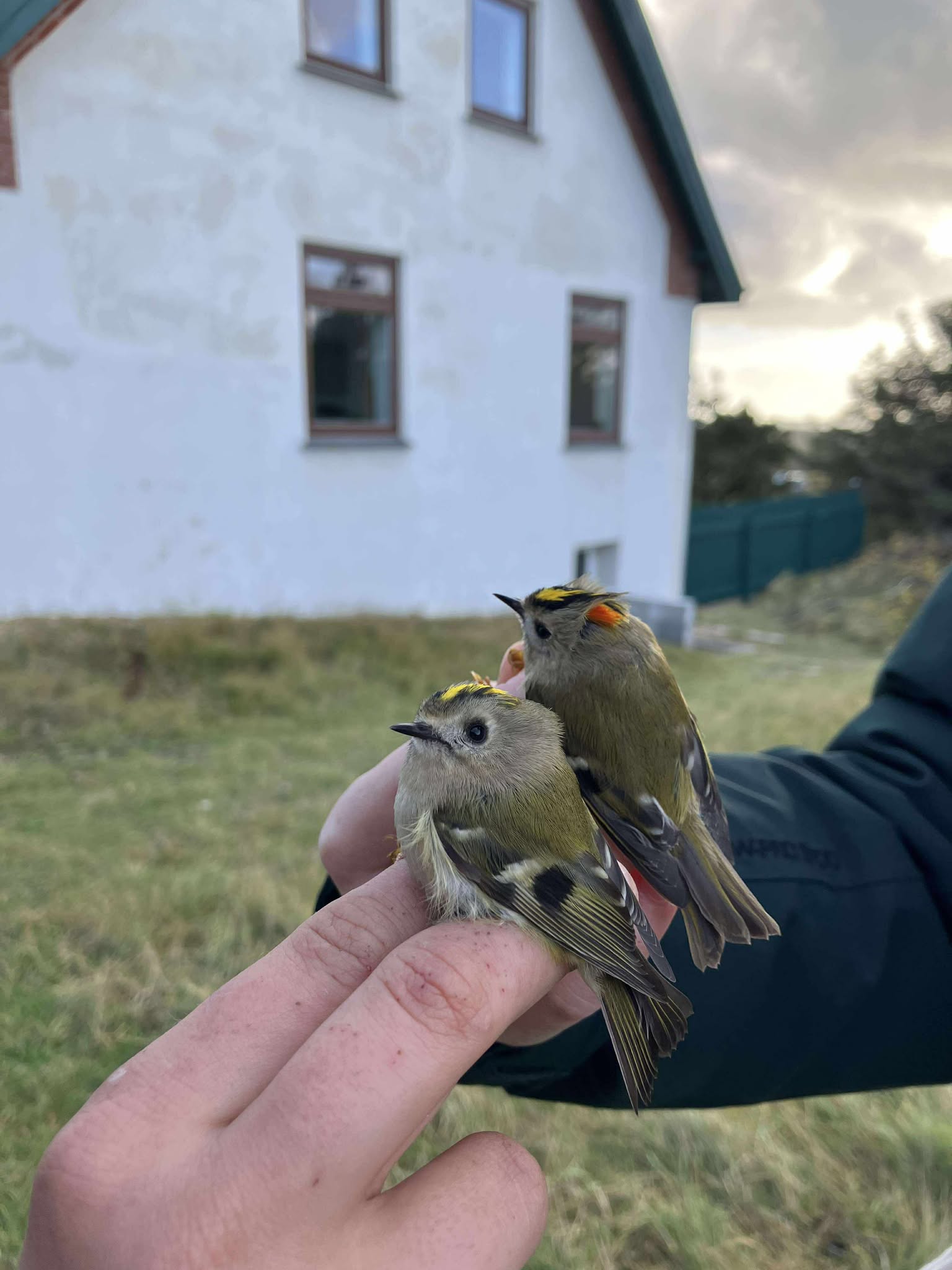
Then we had this adorable goldcrest couple, a few blue tits(obviously) and the bird of the day, two wonderful firecrests!!
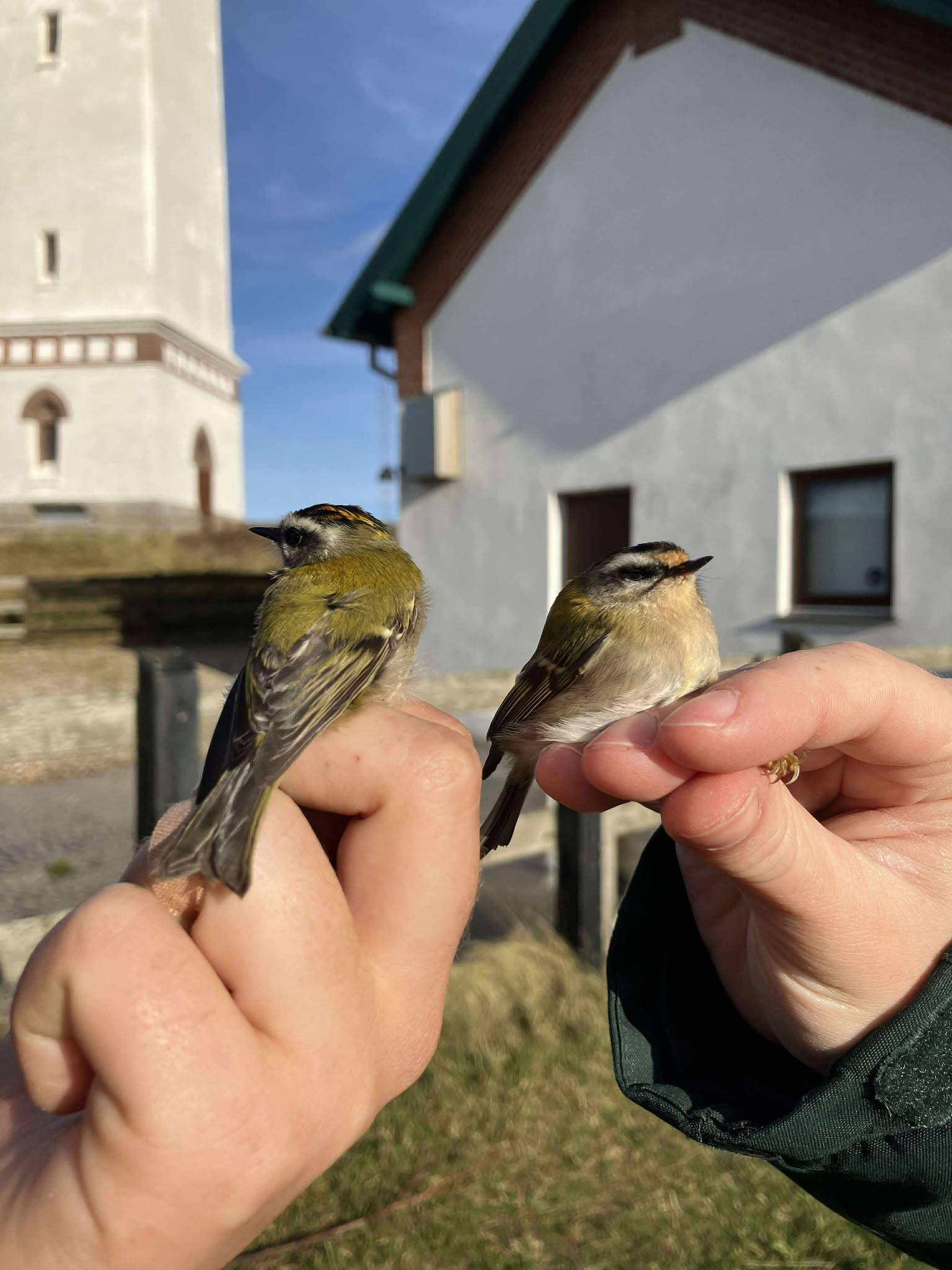
As we had some time in-between we decided to do some maintanence on a few nets and clean the labs windows! Great fun! And with a couple of coal tits as well as a pair of great tits, our day ended with Mathilde and I joining Sverre and Oliver to go twitch a leaf warbler at Tipmosen!
- LK
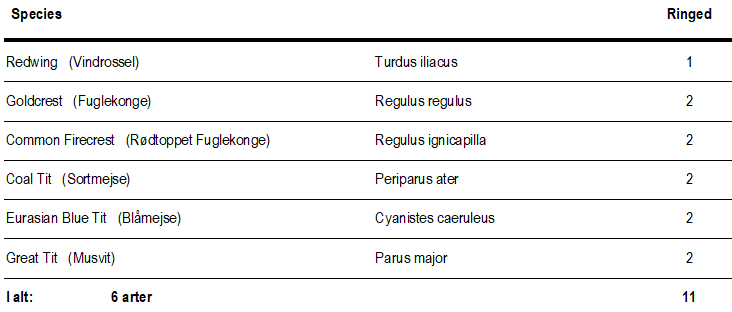
Folk på stationen: Lua Koplin, Sverre Dahl Porsgaard, Mathilde Lundt Larsen, Oliver Laursen, Henrik Böhmer, Thomas Kristensen
Stirrer på stære og tomme net
Morgenobs
Vejret var igen i dag i SØ, hvilket betyder at der kommer endelig kommer lidt varieret fugletræk, ulig NV-vind. Normalt ville vi holde fokuset på havet, men idag kom trækket hovedsageligt over hovedet på os, i form af flere tusinde stære. I første interval (30 min) alene havde vi over 8000 stære, den største flok på 2100! Men vi var 4x så mange folk på klitten som normalt, hvilket hjalp gevaldigt med de mange fugle der skulle skrives ned. Omme bagved heden fløj en kærhøg med nogle sjove kendetegn. Hovedet var mørkere end en blå kærhøg, og seks striber sås på underarmen. Der blev taget billeder og vi venter stadig spænt på en endelig verdikt. Pludselig hørtes der to tik-lyde fra oven. Det var en tik-værling der skulle tjekkes på sonogrammet derhjemme. Der var nogle afvigelser, men blev til sidst bestemt som en dværgværling. Ude på vandet svømmede der en doven islom i vinterdragt lige over militærskuret. En fin dag med en artstotal på 63 arter.
- OLA
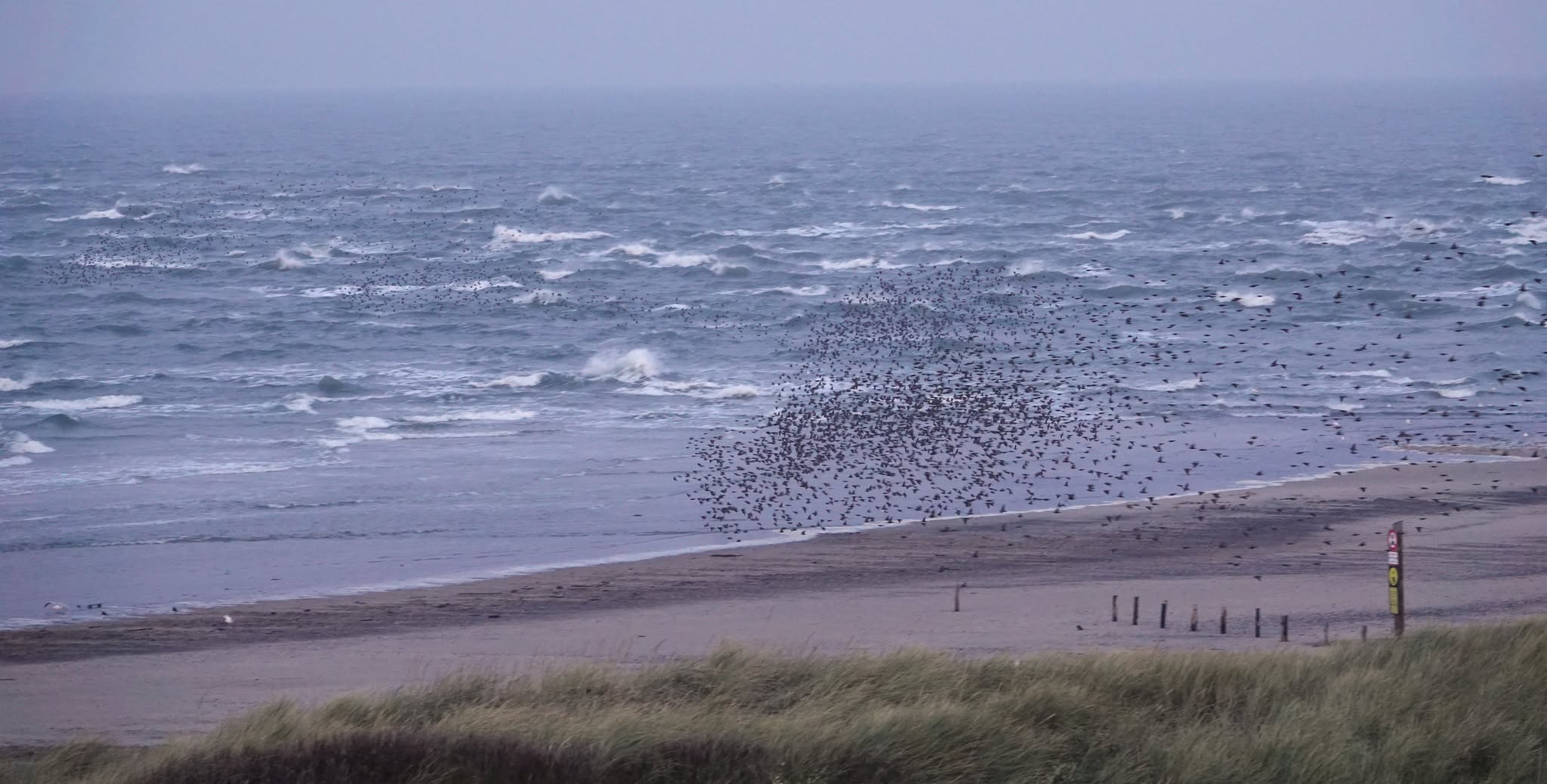
Stor stæreflok. Billede: Henrik Böhmer
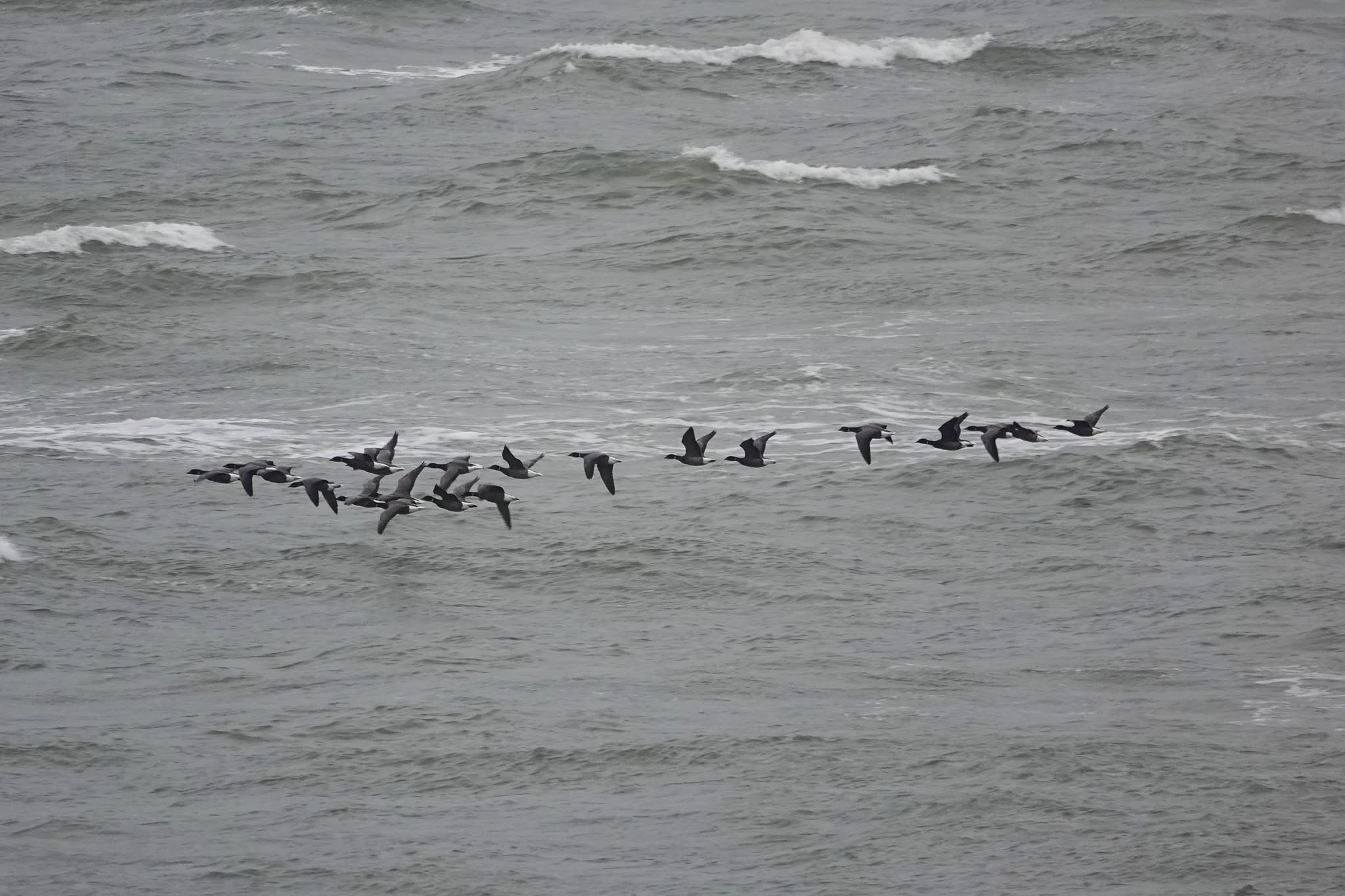
Knortegæs. Billede: Henrik Böhmer
Ringmærkning
Ovenpå en så travl blåmejse-dag i går, gryede dagen med forventninger eller anelser - men det blev ved disse fornemmelser, for dagen viste sig at være utroligt stille i ringmærkningen. Vi satte os klar i ringmærkningslab i stationshaven, hvorfra man kan se de nærmeste net, så vi hurtigt ville kunne springe ud, hvis der skulle komme mange fugle (mejser) i nettene samtidigt, eller hvis det skulle begynde at regne. Jeg brugte tiden på at læse op på et par fældningsmønstre og andre sysler, mens vi holdt øje, som var vi på jagt efter en forbryder. Den eneste fugl der lagde sin vej forbi vores net i dag var en enlig 1k solsort han. Derefter måtte vi ved middagstid lukke net, da regnen faldt og fortsatte resten af dagen. Denne ene fugl må således være dagens fugl blot ved sin usammenlignelige tilstedeværelse.
- MLL
Folk på stationen: Lua Koplin, Sverre Dahl Porsgaard, Mathilde Lundt Larsen, Oliver Laursen, Henrik Böhmer, Bent Jakobsen, Thomas Kristensen, Sverres forældre, Olivers forældre, Molly (Olivers hund)
Uanmeldt besøg af 468 blåmejser
Morgenobs
Dagen står på sydvestenvind hvilket er et kærkomment vindskift. Når vinden skifter så meget retning kan det godt skyde en prop igennem, i dag var denne prop lavet af bogfinker, stære og som altid en helvedes masse blåmejse. Samlet set har der været omkring fire hundrede dagtrækkende blåmejser samt et par tusinde bog/kvækerfinker. Alle blåmejserne fik dog mig (Sverre) til at forlade obsposten til fordel for ringmærkning, så Oliver stod tilbage med en heftig omgang trækfugle der skulle tælles. Veludstyret med seks kliktællere og et godt teleskop kan jeg dog lige forestille mig diverse lærker, mejser og finker fyre rundt om ørerne på ham efterfulgt af lyden af hastige klik. Oliver har således fået registreret hele 42 arter, største delen som alene-observatør. Cadeau for det. Han gik både set/hørt sanglærke, hedelærke og bjerglærker. Alt i alt lyder det som om han havde en skøn dag her på Danmarks vestligste punkt:)
- SDP
Ringmærkning
Morgenen gryede i smeltende smukke farver af fersken og lilla. Således indledtes endnu en dag i Blåvand, som bragte et par gode forskellige arter helt tidligt fra morgenstunden med solsort og til stor glæde nye gærdesmutter og en bogfinke - som jeg ikke har set i nogle dage i nettene.
Hurtigt derefter, i anden runde, fik vi dog som igen igen BLÅMEJSER i alle net i stationshaven! Som dagene går intensiverer blåmejserne, som nu er et element af en hver ringmærkningsdag i større og større grad. Mens vi pillede blåmejser ud af nettene, tænkte vi over, hvor i alverden de allesammen kommer fra og om de mon vil blive fanget sydpå inden længe? Det er mig næsten ubegribeligt, at de kan blive ved og ved med at komme i disse råmængder. Vi fik i dag det næststørste antal på sæsonen med 468 blåmejser (kun overgået af i går). Jeg skrev for blot fire dage siden om at vi ramte 1000 blåmejser for sæsonen, men nu er vi nået over 2000, således dobbelt op på blot fire dage.
Blåmejserne vil blive i mine erindringer længe og pryde på min ringmærkningsliste, som efterhånden tæller et helt utroligt antal af dem. Jeg vil hvile min lidt gennembidte fingre og tænke på alle de blåmejser, der måske flyver forbi den næste tid.
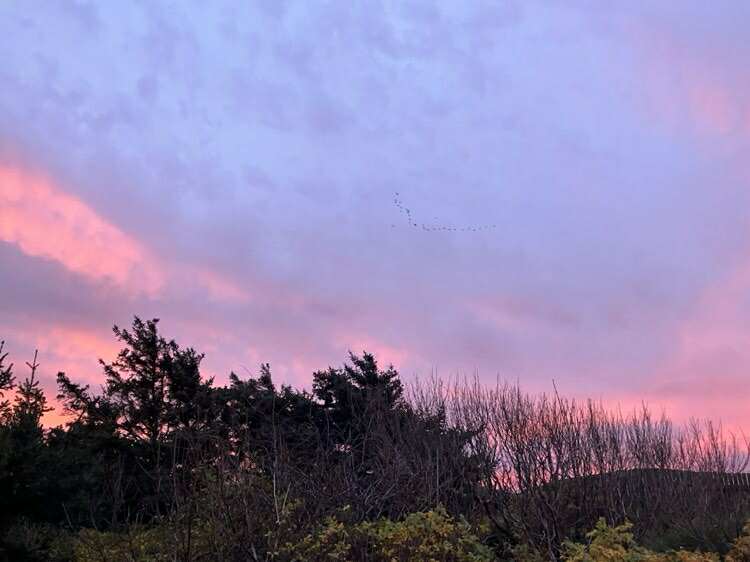
- En dejlig morgenudsigt med grågæs inden alle blåmejserne ankom
- MLL
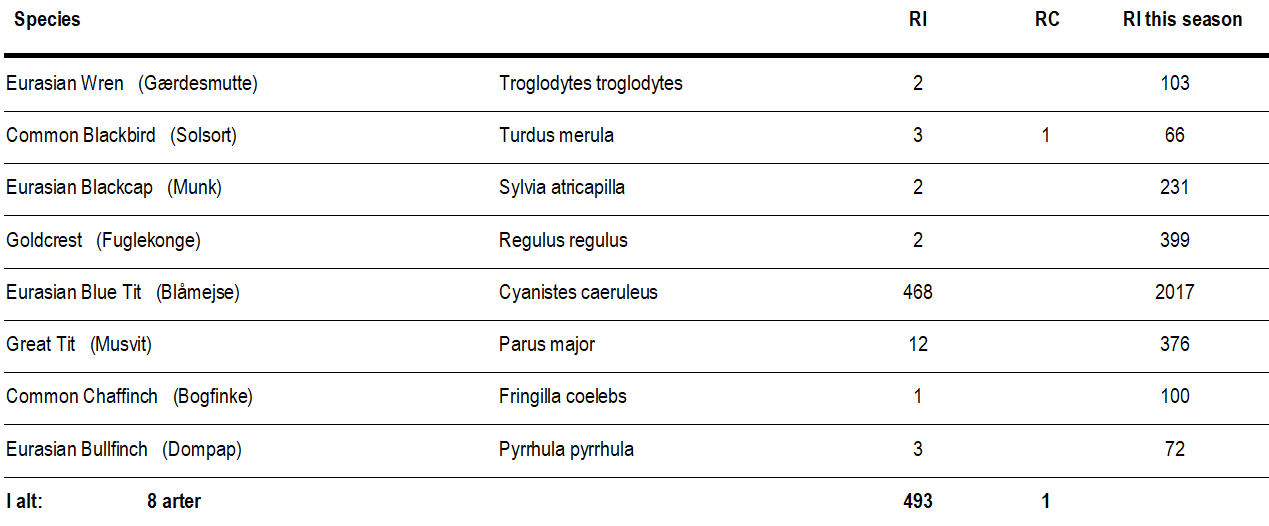
Folk på stationen: Lua Koplin, Sverre Dahl Porsgaard, Mathilde Lundt Larsen, Oliver Laursen
(Blue) TITS!
Morning obs:
Once more the vind was in northwest, meaning our expectations were low. The birds however showed up regardless of the wind. The usual suspects: Little auk, little gull, kittiwake and TITS made the apperance, but the first skua in the last two weeks showed up, with a rather strange flightpattern. The parasitic skua at first site actually gave the impression of a sparrowhawk, it flew with fast wing-beats followed by a sudden stop, and repeat. Regardless it was a skua as pointet out by HBØ. The bird of the day, i am sort of split on. We had another common loon today, but also its the first skua we have had in a while. Soon the parasitic skua will be less common than some of the rarer skuas in denmark, as they switch in abundance here on the west coast. So i would like to put the parasitic skua as the bird of the day, folowed closely by the common loon, that came close to the beach towards south. Other exiting birds are to mention: the two snow buntings southwards and the long-tailed ducks, where two of them were swimming in the waves and another two flying south.
Ringing
The morning started quite calmly and soon the sun came out for a bit, and so did the tits! Today was the biggest day of blue tits we have had this season. What started with joy of catching a few blue tits in the Helgoland trap, soon became all hands on deck with Mathilde, Bent, Henrik, Sverre and myself( Lua) knee-deep in taking out these angry little blue monsters for hours.
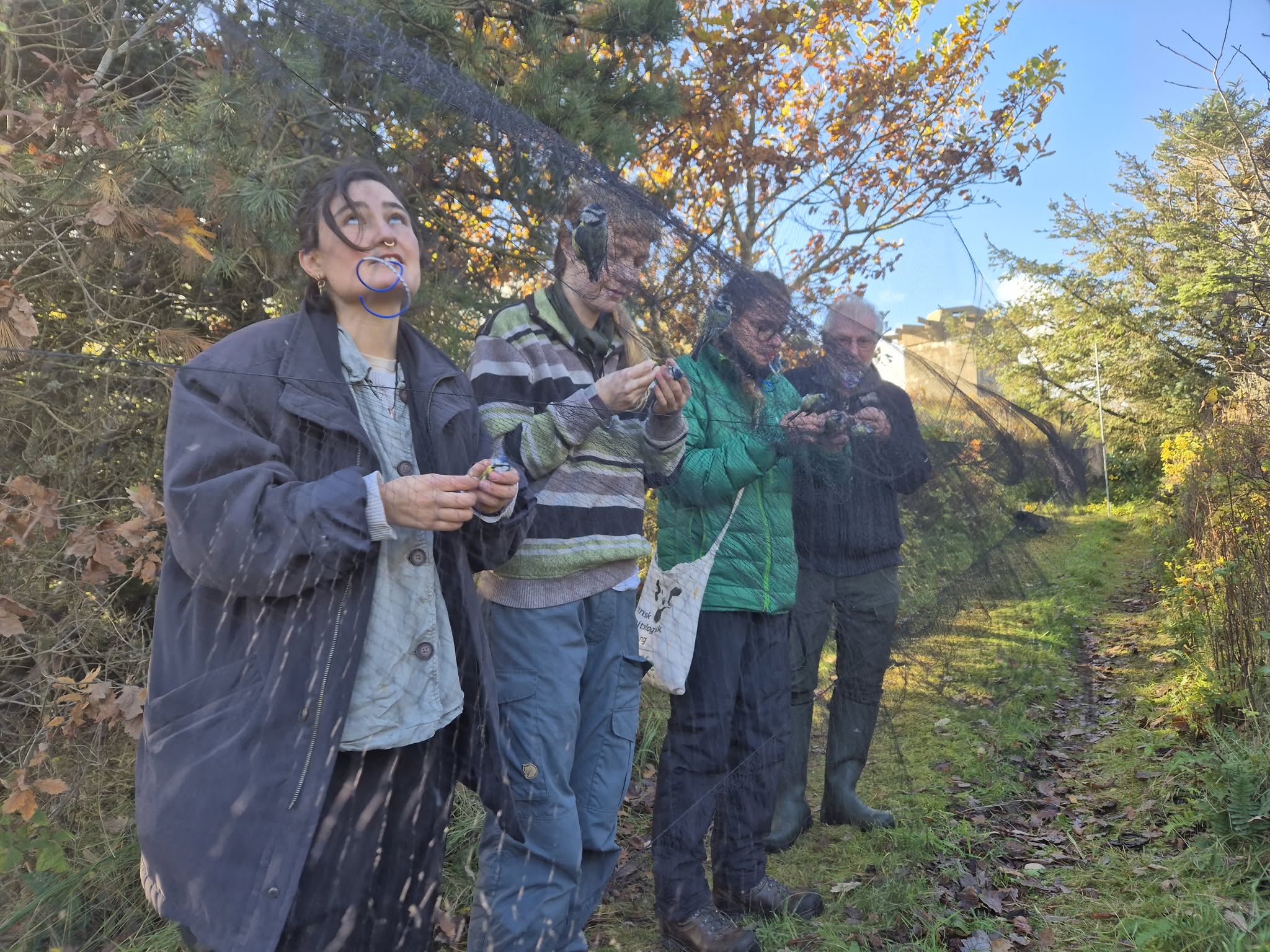
All in high spirit and a positive attitude, of course! After all the action calmed down a bit, we did get a little sweet treat at the end of the day, in the form of this beautiful female firecrest!
-LK
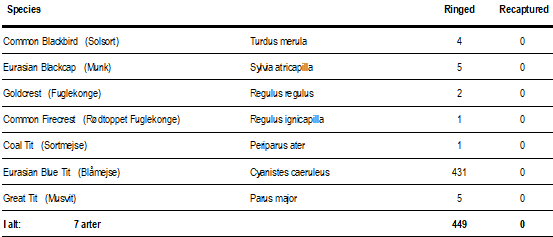
Folk på stationen: Lua Koplin, Sverre Dahl Porsgaard, Mathilde Lundt Larsen, Oliver Laursen, Thomas Kristensen, Henrik Böhmer, Bent Jakobsen
A blue and black day again!
Morning Observations
The birds are back! The southwestern oriented wind is bringing us birds and warmth. we were treated quite well by the birding gods today! Thomas joined us for the first hour of the obs and found us a nice great northern diver (islom), just as he left we had a little auk (søkonge), and another one later! Besides from those nice rarities i enjoyed the great and wonderful comeback of the ducks. We had wigeons, northern pintail and even a goldeneye (Pibeand, spidsand, hvinand). To top it all of i spotted a short eared owl (mosehornugle) flying just above the water, it took plenty off time along the horizon so we enjoyed the view. Also no rain! A great day in blåvand, and hopefully tomorrow will be just as exciting:)
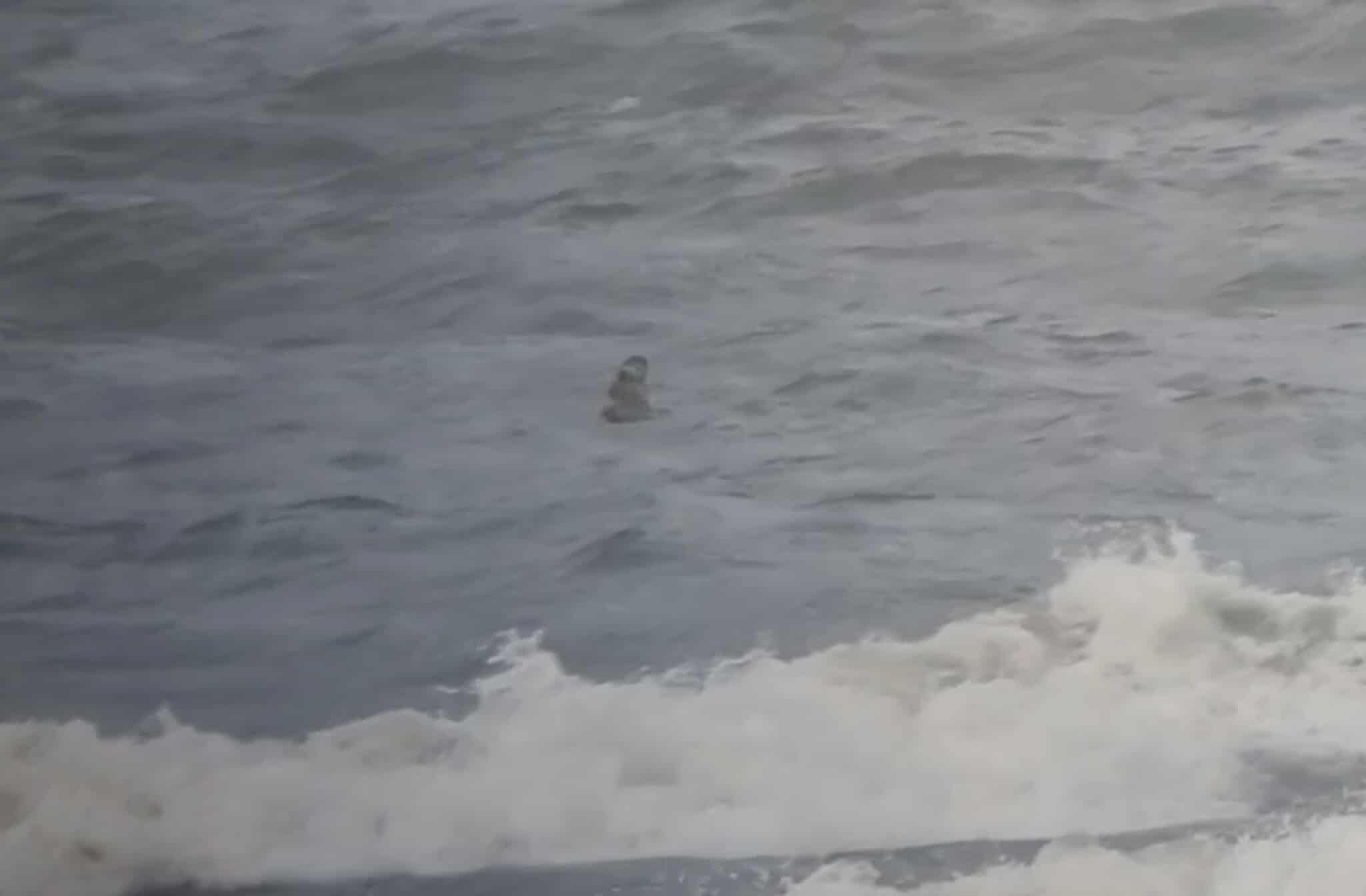
- Short eared owl at the obs
- SDP
Ringing
In full Oktober spirit, every good day lately has started about the same: we all say "today is going to be a bad day..". We are not able to open all the nets due to unsure weather condition, nervously starying at the clouds, whispering "I smell rain." And then the rain does not come, but the birds do, so, we had another great day in terms of numbers, with over 80 blue tits (blåmejse)! Every ringers best friend! Besides these blue little bundles of joy, we also caught Blackcaps(munk), Goldcrest(fuglekong) and a fair number of Blackbirds( solsort)!
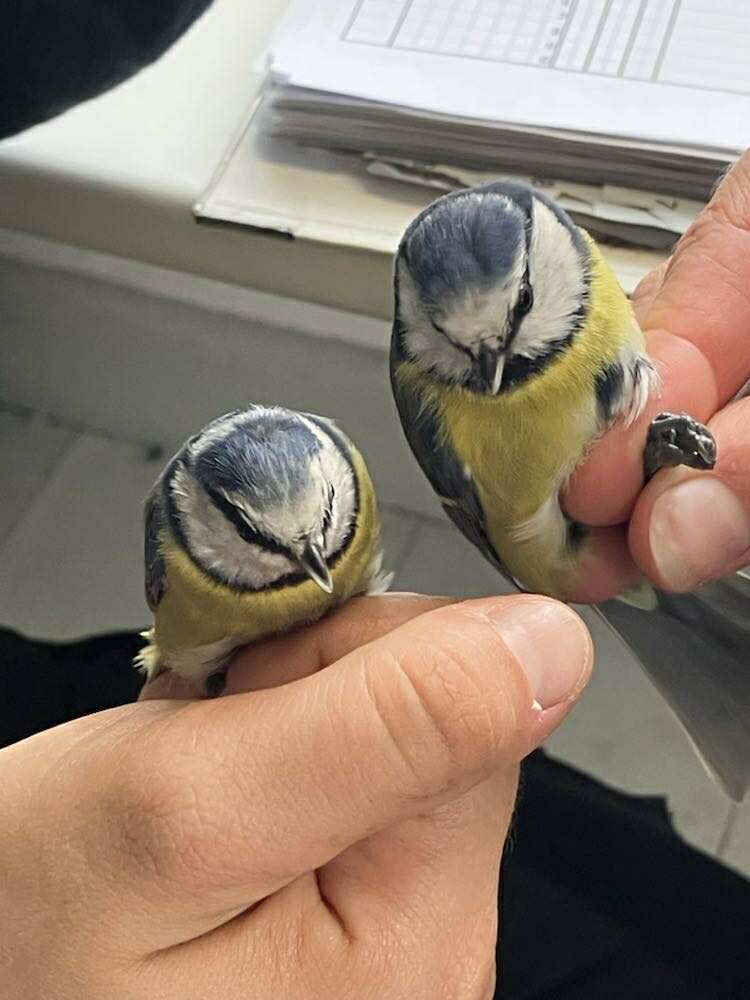
Yesterday, when it did indeed rain for most part of the day and we decided to have a cozy day inside, each of us individualy, like true birders, stared at every bird outside and we all tried to see which of the blackbirds happily hooping around in our garden in the rain had been ringed before and which havent. So today we made sure to look at every caught blackbird and decide if it was one of the unringed of the day before, which Im pretty sure they all were!
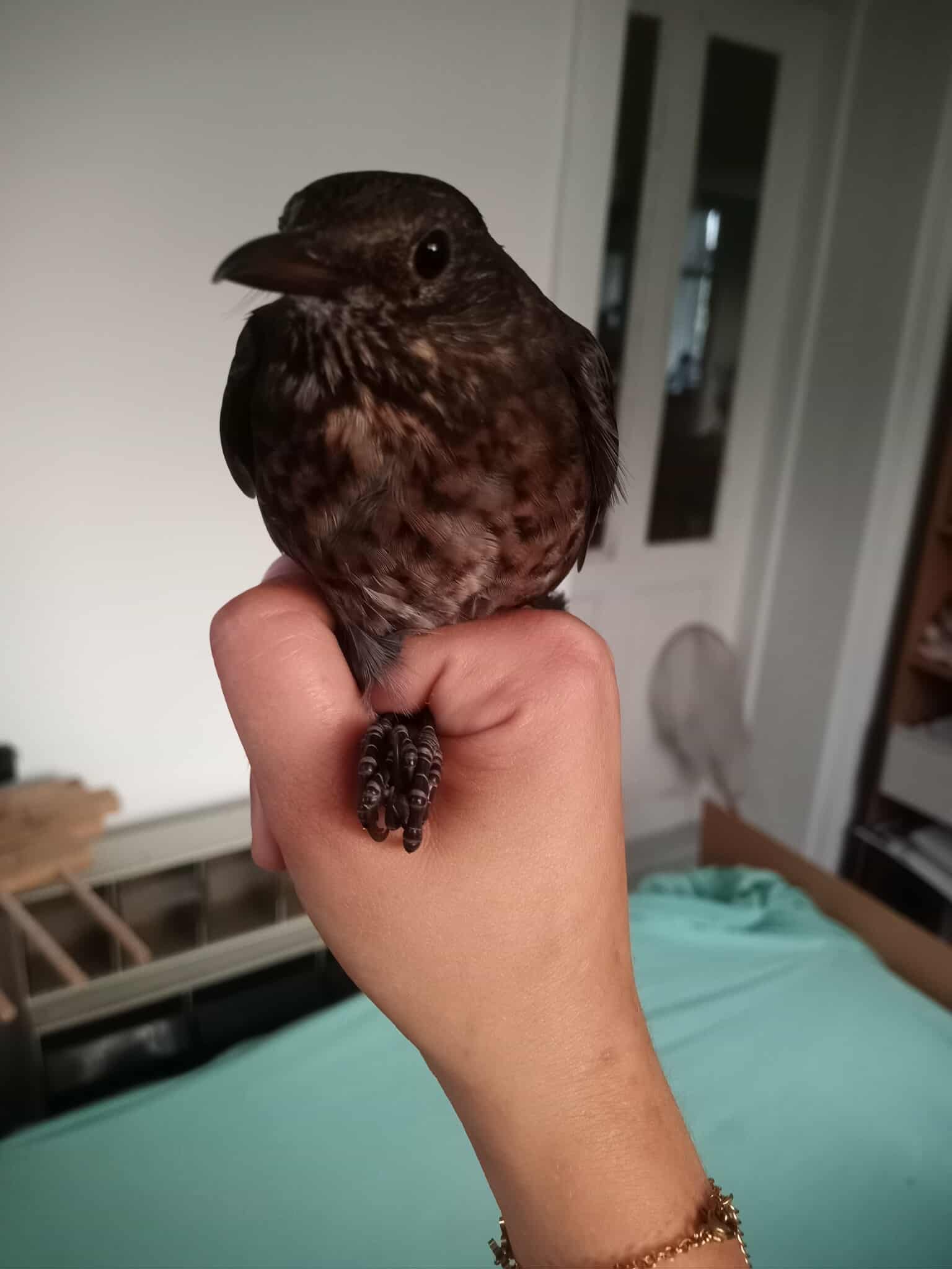
-LK
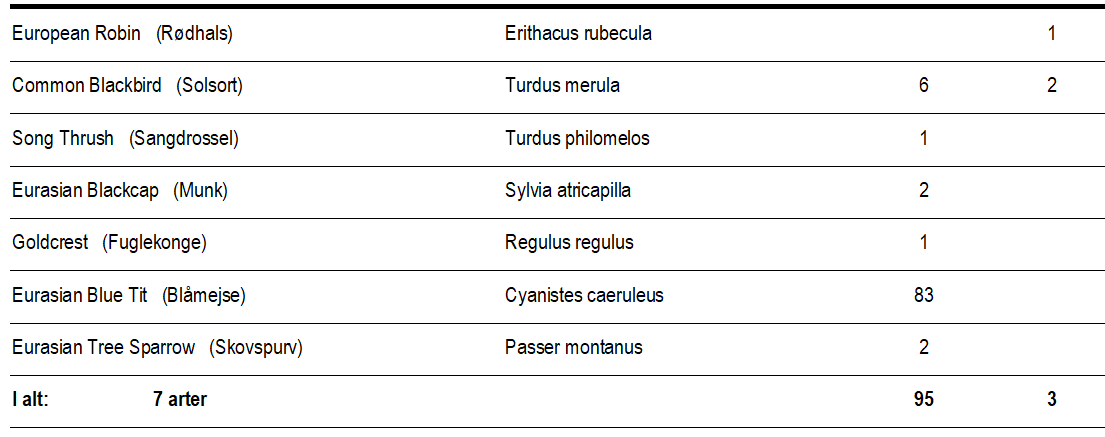
Folk på stationen: Lua Koplin, Sverre Dahl Porsgaard, Mathilde Lundt Larsen, Oliver Laursen
Så kom efteråret
Morgenobs
I dag har været en stille dag herude på det vestligste punkt. Dagen startede med nordvestenvind og regn og ser ud til at slutte med nordvestenvind og regn. Vi klarede de første to ud af de tre timers observation næsten tørre, derefter begyndte det at pøse ned så vi måtte søge skjul på stationen. I den korte tid vi var ude var det dog pænt stille med fuglene, jeg brugte lang tid på at frygte at dte meste spændende i dag ville være sortænder, men så kom der heldigvis en enkelt pibeand som erklærede sig selv som vinder... ikke særlig spændende. Nå men vi harf heldigvis hygget på stationen ved at lave halloween-græskar og pudse teleskoper og kikkerter så vi er klar til at det forhåbentligt klarer op igen en dag. Vi skrives ved imorgen til endnu en god (og sikkert våd) dag på 'Hukket :)
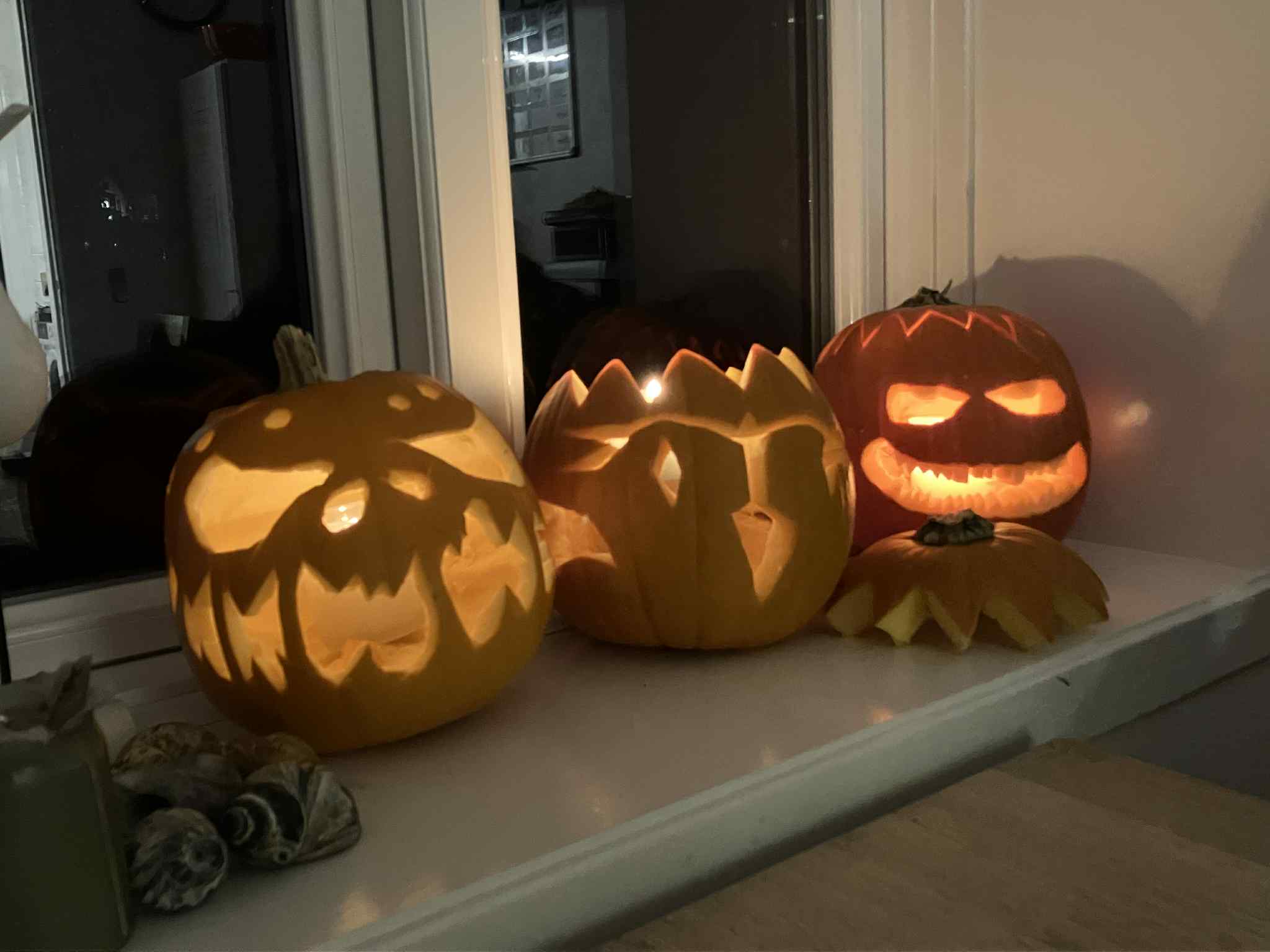
- SDP
Ringmærkning
Dagen i dag var for våd til at åbne nettene
Folk på stationen: Lua Koplin, Sverre Dahl Porsgaard, Mathilde Lundt Larsen, Oliver Laursen
